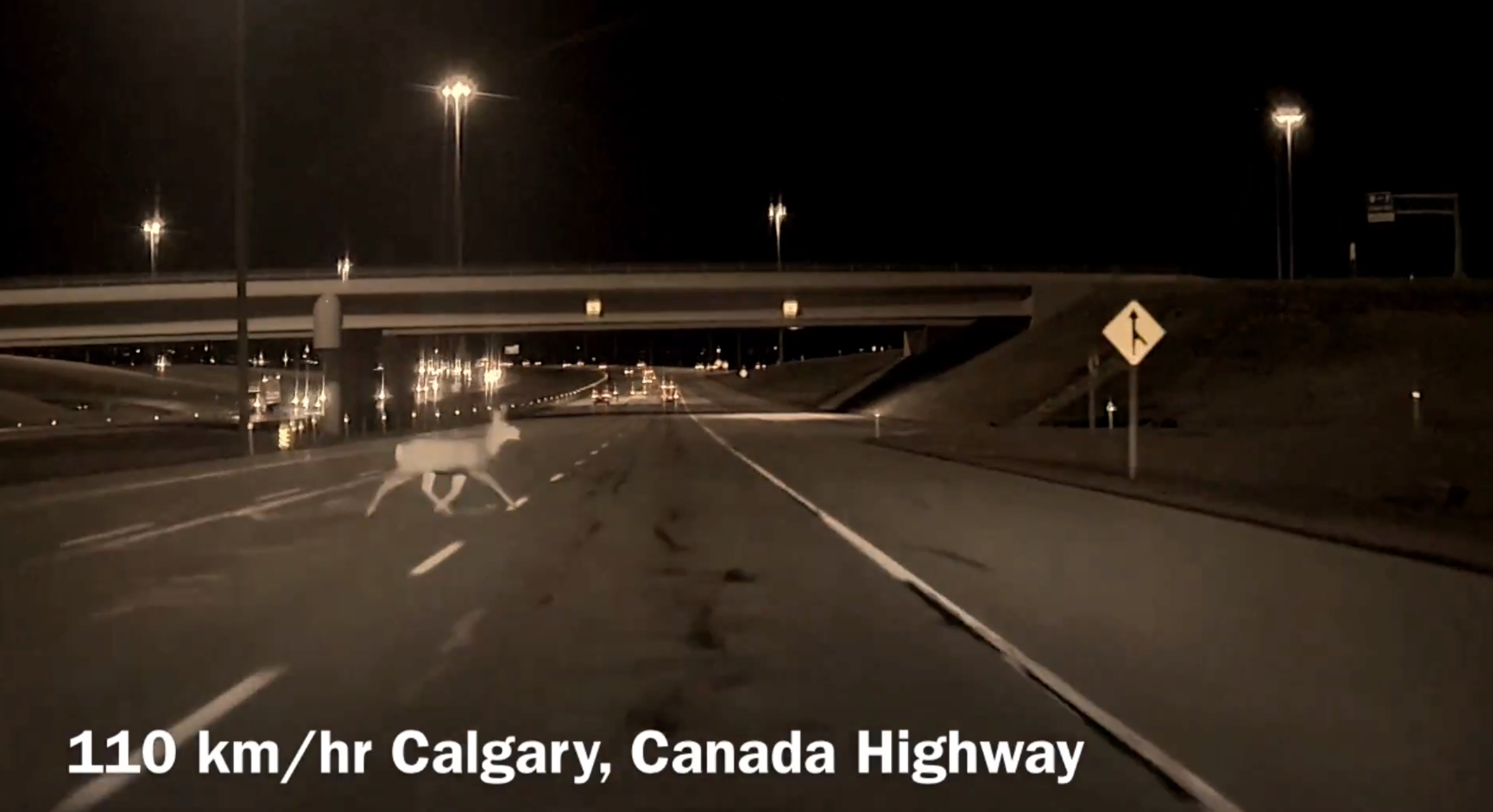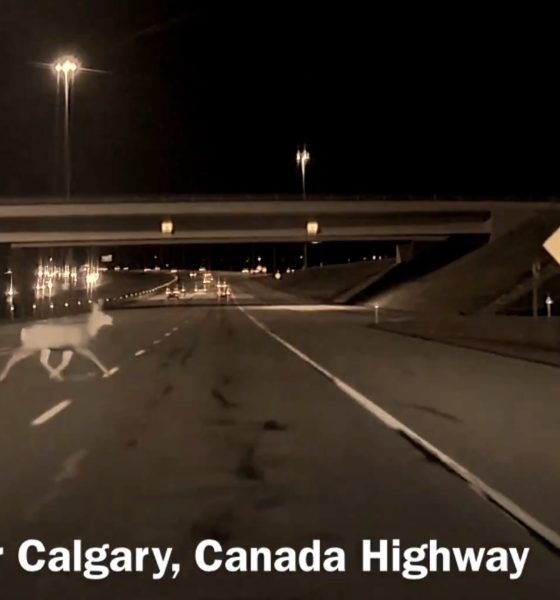Tesla’s Supervised Full Self-Driving (FSD) has been the subject of public and regulatory debate over the past few years, though the automaker has recently highlighted an instance in which the software seems to have prevented a serious accident for one family.
On Sunday, X user Manoranjan Haobam shared video footage from their trip in a Tesla in Calgary, Canada, during which the driver did not see a deer approaching while driving 110 km/hr (~68 mph). Fortunately, Tesla’s FSD braked at the last second, seemingly preventing the car from colliding with the animal, and potentially saving the family’s lives.
Haobam details the near-miss below:
“Tesla FSD just saved our family, a deer, and the car! Driving at 110 km/h when a deer suddenly crossed our path—Tesla’s Full Self-Driving instantly detected it, smoothly braked, and prevented what could have been a major accident. Grateful for this life-saving tech!”
Tesla FSD just saved our family, a deer, and the car! Driving at 110 km/h when a deer suddenly crossed our path—Tesla’s Full Self-Driving instantly detected it, smoothly braked, and prevented what could have been a major accident. Grateful for this life-saving tech! #TeslaFSD… pic.twitter.com/tag55nNKsx
— Manoranjan Haobam (@HaobamMano) November 10, 2024
Tesla also reposted the video, highlighting that the software avoided the wildlife collision.
Tesla’s Supervised Full Self-Driving, Regulator Scrutiny, Cybercab
The company has regularly stated that it aims to make FSD Supervised safer than a human driver, and it constantly improves the system with software updates, not unlike what it does with its cars overall. The FSD Supervised system is also trained by real-time video footage from those who have it engaged while driving, and it’s this trained AI “neural network” and the vehicle’s suite of cameras that inform the system’s decision-making.
Still, the company provides several warnings to drivers in its cars and manual that they should be prepared to re-gain control of the vehicle. Tesla notes that driver intervention may be required in certain scenarios, especially with regards to narrow roads with oncoming cars, construction zones, or any time drivers are going through more complex intersections.
In its owners manuals, Tesla also warns that FSD Supervised is a “hands-on feature that requires you to pay attention to the road at all times,” adding the following warning for drivers:
Keep your hands on the steering wheel at all times, be mindful of road conditions and surrounding traffic, pay attention to pedestrians and cyclists, and always be prepared to take immediate action (especially around blind corners, crossing intersections, and in narrow driving situations). Failure to follow these instructions could cause damage, serious injury or death. It is your responsibility to familiarize yourself with the limitations of Full Self-Driving (Supervised) and the situations in which it may not work as expected.
Tesla has also been the subject of significant public and regulator scrutiny over the past few years, with the National Highway Traffic Safety Administration (NHTSA) this week opening a preliminary investigation into the company’s social media portrayals of FSD Supervised. The agency has requested more information from the company on certain low-visibility conditions, as well as claiming that the company’s advertisements condone “disengaged driving behavior.”
Tesla releases a quarterly safety report for its Autopilot and FSD Supervised systems, comparing the number of incidents with the systems engaged to the NHTSA average in the U.S. In Q3, Tesla’s vehicles using Autopilot averaged one crash for every 7.08 million miles driven, compared to one crash per every 670,000 recorded in the latest NHTSA data.
The instance also comes exactly a month after Tesla unveiled its Cybercab two-seater robotaxi at an event in Southern California, set to be sold without a steering wheel or pedals. Teslarati was among the first to take a ride in the self-driving taxi, and you can see our full experience in the Cybercab below.
?: Our FULL first ride in the @Tesla Cybercab pic.twitter.com/6gR7OgKRCz
— TESLARATI (@Teslarati) October 11, 2024
Tesla FSD update makes speed profiles available on more roads
What are your thoughts? Let me know at zach@teslarati.com, find me on X at @zacharyvisconti, or send us tips at tips@teslarati.com.
Need accessories for your Tesla? Check out the Teslarati Marketplace:

News
Tesla FSD fleet is nearing 7 billion total miles, including 2.5 billion city miles
As can be seen on Tesla’s official FSD webpage, vehicles equipped with the system have now navigated over 6.99 billion miles.

Tesla’s Full Self-Driving (Supervised) fleet is closing in on almost 7 billion total miles driven, as per data posted by the company on its official FSD webpage.
These figures hint at the massive scale of data fueling Tesla’s rapid FSD improvements, which have been quite notable as of late.
FSD mileage milestones
As can be seen on Tesla’s official FSD webpage, vehicles equipped with the system have now navigated over 6.99 billion miles. Tesla owner and avid FSD tester Whole Mars Catalog also shared a screenshot indicating that from the nearly 7 billion miles traveled by the FSD fleet, more than 2.5 billion miles were driven inside cities.
City miles are particularly valuable for complex urban scenarios like unprotected turns, pedestrian interactions, and traffic lights. This is also the difference-maker for FSD, as only complex solutions, such as Waymo’s self-driving taxis, operate similarly on inner-city streets. And even then, incidents such as the San Francisco blackouts have proven challenging for sensor-rich vehicles like Waymos.
Tesla’s data edge
Tesla has a number of advantages in the autonomous vehicle sector, one of which is the size of its fleet and the number of vehicles training FSD on real-world roads. Tesla’s nearly 7 billion FSD miles then allow the company to roll out updates that make its vehicles behave like they are being driven by experienced drivers, even if they are operating on their own.
So notable are Tesla’s improvements to FSD that NVIDIA Director of Robotics Jim Fan, after experiencing FSD v14, noted that the system is the first AI that passes what he described as a “Physical Turing Test.”
“Despite knowing exactly how robot learning works, I still find it magical watching the steering wheel turn by itself. First it feels surreal, next it becomes routine. Then, like the smartphone, taking it away actively hurts. This is how humanity gets rewired and glued to god-like technologies,” Fan wrote in a post on X.
News
Tesla starts showing how FSD will change lives in Europe
Local officials tested the system on narrow country roads and were impressed by FSD’s smooth, human-like driving, with some calling the service a game-changer for everyday life in areas that are far from urban centers.

Tesla has launched Europe’s first public shuttle service using Full Self-Driving (Supervised) in the rural Eifelkreis Bitburg-Prüm region of Germany, demonstrating how the technology can restore independence and mobility for people who struggle with limited transport options.
Local officials tested the system on narrow country roads and were impressed by FSD’s smooth, human-like driving, with some calling the service a game-changer for everyday life in areas that are far from urban centers.
Officials see real impact on rural residents
Arzfeld Mayor Johannes Kuhl and District Administrator Andreas Kruppert personally tested the Tesla shuttle service. This allowed them to see just how well FSD navigated winding lanes and rural roads confidently. Kruppert said, “Autonomous driving sounds like science fiction to many, but we simply see here that it works totally well in rural regions too.” Kuhl, for his part, also noted that FSD “feels like a very experienced driver.”
The pilot complements the area’s “Citizen Bus” program, which provides on-demand rides for elderly residents who can no longer drive themselves. Tesla Europe shared a video of a demonstration of the service, highlighting how FSD gives people their freedom back, even in places where public transport is not as prevalent.
What the Ministry for Economic Affairs and Transport says
Rhineland-Palatinate’s Minister Daniela Schmitt supported the project, praising the collaboration that made this “first of its kind in Europe” possible. As per the ministry, the rural rollout for the service shows FSD’s potential beyond major cities, and it delivers tangible benefits like grocery runs, doctor visits, and social connections for isolated residents.
“Reliable and flexible mobility is especially vital in rural areas. With the launch of a shuttle service using self-driving vehicles (FSD supervised) by Tesla in the Eifelkreis Bitburg-Prüm, an innovative pilot project is now getting underway that complements local community bus services. It is the first project of its kind in Europe.
“The result is a real gain for rural mobility: greater accessibility, more flexibility and tangible benefits for everyday life. A strong signal for innovation, cooperation and future-oriented mobility beyond urban centers,” the ministry wrote in a LinkedIn post.
News
Tesla China quietly posts Robotaxi-related job listing
Tesla China is currently seeking a Low Voltage Electrical Engineer to work on circuit board design for the company’s autonomous vehicles.

Tesla has posted a new job listing in Shanghai explicitly tied to its Robotaxi program, fueling speculation that the company is preparing to launch its dedicated autonomous ride-hailing service in China.
As noted in the listing, Tesla China is currently seeking a Low Voltage Electrical Engineer to work on circuit board design for the company’s autonomous vehicles.
Robotaxi-specific role
The listing, which was shared on social media platform X by industry watcher @tslaming, suggested that Tesla China is looking to fill the role urgently. The job listing itself specifically mentions that the person hired for the role will be working on the Low Voltage Hardware team, which would design the circuit boards that would serve as the nervous system of the Robotaxi.
Key tasks for the role, as indicated in the job listing, include collaboration with PCB layout, firmware, mechanical, program management, and validation teams, among other responsibilities. The role is based in Shanghai.
China Robotaxi launch
China represents a massive potential market for robotaxis, with its dense urban centers and supportive policies in select cities. Tesla has limited permission to roll out FSD in the country, though despite this, its vehicles have been hailed as among the best in the market when it comes to autonomous features. So far, at least, it appears that China supports Tesla’s FSD and Robotaxi rollout.
This was hinted at in November, when Tesla brought the Cybercab to the 8th China International Import Expo (CIIE) in Shanghai, marking the first time that the autonomous two-seater was brought to the Asia-Pacific region. The vehicle, despite not having a release date in China, received a significant amount of interest among the event’s attendees.










